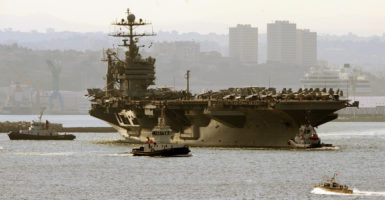A U.S. carrier strike group recently deployed. But it did so without a key component—the carrier itself.
Due to electrical maintenance, the USS Harry S. Truman stayed home, missing its scheduled deployment.
That’s significant, because every other carrier strike group—aircraft carriers included—has been fully deployed from the East Coast since 2006.
Aircraft carriers are an important tool for projecting power abroad. Imposing and powerful, they provide a movable airfield to hot spots around the globe and project forward naval presence, along with their escort ships.
The Truman staying home is a big loss for U.S. naval capability.
Two key issues currently plague the sustainment of the Navy: inadequate funding for repairs and a shortage of dry docks, where repairs are conducted.
First, the Navy currently faces a $1.8 billion roadblock to achieving full naval readiness.
According to the Senate Armed Services Committee chairman, Sen. James Inhofe, R-Okla., other defense priorities have consumed the funds that would have covered the $1.8 billion maintenance funding shortfall.
Second, dry dock shortages prevent timely repairs. The Navy’s long-range plan for maintenance and modernization of naval vessels for fiscal 2020 observes that docks are overloaded.
Some 109 vessels are already competing for 21 aging dry docks on the East Coast, where the Truman is being serviced.
Insufficient funding and porous infrastructure slows the U.S. response to emerging threats and decreases its capability to deter future threats.
Resulting from sparse resources, project delays limit our global reach. Data between 2012 and 2018 reveal that 70% of naval repairs were not finished on time.
For example, the USS George H.W. Bush, a nuclear-powered aircraft carrier, was ready for deployment nearly a year-and-a-half after its maintenance’s scheduled completion.
Before the USS Harry S. Truman’s deployment was delayed, the Navy already found that it couldn’t meet the long-established standard of deploying two aircraft carriers while having three others ready to spring into action within 30 days, hindering the Navy’s deployment agility.
The USS Harry S. Truman’s postponed deployment also disrupts current naval missions. Taking the aircraft carrier out of play may place more strain on its deployed counterpart, the USS Abraham Lincoln, which is America’s only currently deployed aircraft carrier.
Tom Callender, a former senior research fellow for defense programs at The Heritage Foundation, noted in a 2018 report that while full naval deployment isn’t always possible, the United States should aim to maximally deploy its fleets so it can respond to threats on time.
But delayed projects and backlogging prevent the taking on of unexpected challenges. Adm. William Moran, vice chief of naval operations, emphasized that “too much time for maintenance has a negative impact on meeting planned training and operational schedules, and the corresponding negative impact on the readiness of our sailors to fight.”
While increasing threats and dwindling resources define the Navy’s current battlefield, the solution does not lie in retiring older ships such as the USS Harry S. Truman, as The Heritage Foundation’s previous naval reports explain.
Rather, the infrastructure that receives, repairs, and then redeploys our naval vessels deserves greater investment.
A forward naval presence cannot be realized without providing resources to maintain a world-class Navy.
Especially as Russia and China fortify their navies, U.S. superiority will be solidified with greater investment in our naval capacities.

























